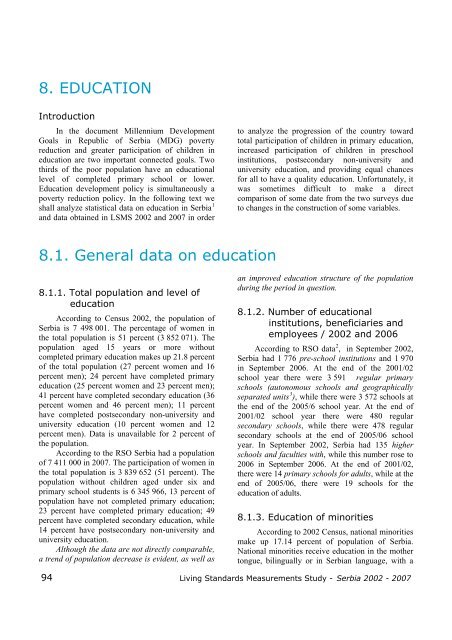Living Standards Measurements Study - Serbia 2002 - 2007
Living Standards Measurements Study - Serbia 2002 - 2007
Living Standards Measurements Study - Serbia 2002 - 2007
You also want an ePaper? Increase the reach of your titles
YUMPU automatically turns print PDFs into web optimized ePapers that Google loves.
8. EDUCATION<br />
Introduction<br />
In the document Millennium Development<br />
Goals in Republic of <strong>Serbia</strong> (MDG) poverty<br />
reduction and greater participation of children in<br />
education are two important connected goals. Two<br />
thirds of the poor population have an educational<br />
level of completed primary school or lower.<br />
Education development policy is simultaneously a<br />
poverty reduction policy. In the following text we<br />
shall analyze statistical data on education in <strong>Serbia</strong> 1<br />
and data obtained in LSMS <strong>2002</strong> and <strong>2007</strong> in order<br />
to analyze the progression of the country toward<br />
total participation of children in primary education,<br />
increased participation of children in preschool<br />
institutions, postsecondary non-university and<br />
university education, and providing equal chances<br />
for all to have a quality education. Unfortunately, it<br />
was sometimes difficult to make a direct<br />
comparison of some date from the two surveys due<br />
to changes in the construction of some variables.<br />
8.1. General data on education<br />
8.1.1. Total population and level of<br />
education<br />
According to Census <strong>2002</strong>, the population of<br />
<strong>Serbia</strong> is 7 498 001. The percentage of women in<br />
the total population is 51 percent (3 852 071). The<br />
population aged 15 years or more without<br />
completed primary education makes up 21.8 percent<br />
of the total population (27 percent women and 16<br />
percent men); 24 percent have completed primary<br />
education (25 percent women and 23 percent men);<br />
41 percent have completed secondary education (36<br />
percent women and 46 percent men); 11 percent<br />
have completed postsecondary non-university and<br />
university education (10 percent women and 12<br />
percent men). Data is unavailable for 2 percent of<br />
the population.<br />
According to the RSO <strong>Serbia</strong> had a population<br />
of 7 411 000 in <strong>2007</strong>. The participation of women in<br />
the total population is 3 839 652 (51 percent). The<br />
population without children aged under six and<br />
primary school students is 6 345 966, 13 percent of<br />
population have not completed primary education;<br />
23 percent have completed primary education; 49<br />
percent have completed secondary education, while<br />
14 percent have postsecondary non-university and<br />
university education.<br />
Although the data are not directly comparable,<br />
a trend of population decrease is evident, as well as<br />
an improved education structure of the population<br />
during the period in question.<br />
8.1.2. Number of educational<br />
institutions, beneficiaries and<br />
employees / <strong>2002</strong> and 2006<br />
According to RSO data 2 , in September <strong>2002</strong>,<br />
<strong>Serbia</strong> had 1 776 pre-school institutions and 1 970<br />
in September 2006. At the end of the 2001/02<br />
school year there were 3 591 regular primary<br />
schools (autonomous schools and geographically<br />
separated units 3 ), while there were 3 572 schools at<br />
the end of the 2005/6 school year. At the end of<br />
2001/02 school year there were 480 regular<br />
secondary schools, while there were 478 regular<br />
secondary schools at the end of 2005/06 school<br />
year. In September <strong>2002</strong>, <strong>Serbia</strong> had 135 higher<br />
schools and faculties with, while this number rose to<br />
2006 in September 2006. At the end of 2001/02,<br />
there were 14 primary schools for adults, while at the<br />
end of 2005/06, there were 19 schools for the<br />
education of adults.<br />
8.1.3. Education of minorities<br />
According to <strong>2002</strong> Census, national minorities<br />
make up 17.14 percent of population of <strong>Serbia</strong>.<br />
National minorities receive education in the mother<br />
tongue, bilingually or in <strong>Serbia</strong>n language, with a<br />
94 <strong>Living</strong> <strong>Standards</strong> <strong>Measurements</strong> <strong>Study</strong> - <strong>Serbia</strong> <strong>2002</strong> - <strong>2007</strong>















